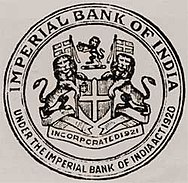State Bank of India is an Indian multinational public sector bank and financial services statutory body headquartered
INDIA OF BANK SYSTEM IS MUMBIA
State Bank of India (SBI) is an Indian multinational public sector bank and financial services statutory body headquartered in Mumbai, Maharashtra. SBI is the 48th largest bank in the world by total assets and ranked 221st in the Fortune Global 500 list of the world's biggest corporations of 2020, being the only Indian bank on the list It is a public sector bank and the largest bank in India with a 23% market share by assets and a 25% share of the total loan and deposits market It is also the fifth largest employer in India with nearly 250,000 employees On 14 September 2022, State Bank of India became the third lender (after HDFC Bank and ICICI Bank) and seventh Indian company to cross the ₹ 5-trillion market capitalisation on the Indian stock exchanges for the first time.[16]
The bank descends from the Bank of Calcutta, founded in 1806 via the Imperial Bank of India, making it the oldest commercial bank in the Indian subcontinent. The Bank of Madras merged into the other two presidency banks in British India, the Bank of Calcutta and the Bank of Bombay, to form the Imperial Bank of India, which in turn became the State Bank of India in 1955 ] Overall the bank has been formed from the merger and acquisition of more than twenty banks over the course of its 200 year history The Government of India took control of the Imperial Bank of India in 1955, with Reserve Bank of India (India's central bank) taking a 60% stake, renaming it State Bank of India.
On 16th Aug 2022 an attempt to facilitate and support start-ups in the country, the State Bank of India (SBI) announced the launch of its first "state-of-the-art" dedicated branch for start-ups in the country in Bengaluru.[20]



The roots of State Bank of India lie in the first decade of the 19th century when the Bank of Calcutta later renamed the Bank of Bengal, was established on 2 June 1806. The Bank of Bengal was one of three Presidency banks, the other two being the Bank of Bombay (incorporated on 15 April 1840) and the Bank of Madras (incorporated on 1 July 1843). All three Presidency banks were incorporated as joint stock companies and were the result of royal charters. These three banks received the exclusive right to issue paper currency till 1861 when, with the Paper Currency Act, the right was taken over by the Government of India. The Presidency banks amalgamated on 27 January 1921, and the re-organised banking entity took as its name Imperial Bank of India. The Imperial Bank of India remained a joint-stock company but without Government participation.
Pursuant to the provisions of the State Bank of India Act of 1955, the Reserve Bank of India, which is India's central bank, acquired a controlling interest in the Imperial Bank of India. On 1 July 1955, the Imperial Bank of India became the State Bank of India. In 2008, the Government of India acquired the Reserve Bank of India's stake in SBI so as to remove any conflict of interest because the RBI is the country's banking regulatory authority.
In 1959, the government passed the State Bank of India (Subsidiary Banks) Act. This made eight banks that had belonged to princely states into subsidiaries of SBI. This was at the time of the First Five Year Plan, which prioritised the development of rural India. The government integrated these banks into the State Bank of India system to expand its rural outreach. In 1963 SBI merged State Bank of Jaipur (est. 1943) and State Bank of Bikaner (est.1944).
SBI has acquired local banks in rescues. The first was the Bank of Bihar (est. 1911), which SBI acquired in 1969, together with its 28 branches. The next year SBI acquired National Bank of Lahore (est. 1942), which had 24 branches. Five years later, in 1975, SBI acquired Krishnaram Baldeo Bank, which had been established in 1916 in Gwalior State, under the patronage of Maharaja Madho Rao Scindia. The bank had been the Dukan Pichadi, a small moneylender, owned by the Maharaja. The new bank's first manager was Jall N. Broacha. In 1985, SBI acquired the Bank of Cochin in Kerala, which had 120 branches. SBI was the acquirer as its affiliate, the State Bank of Travancore, already had an extensive network in Kerala.

National Institute of Design, Ahmedabad designed the SBI logo in 1971.[21]
There was, even before it actually happened, a proposal to merge all the associate banks into SBI to create a single very large bank and streamline operations.[22]
The first step towards unification occurred on 13 August 2008 when State Bank of Saurashtra merged with SBI, reducing the number of associate state banks from seven to six. On 19 June 2009, the SBI board approved the absorption of State Bank of Indore, in which SBI held 98.3%. (Individuals who held the shares prior to its takeover by the government held the balance of 1.7%.)[23]
The acquisition of State Bank of Indore added 470 branches to SBI's existing network of branches. Also, following the acquisition, SBI's total assets approached ₹10 trillion. The total assets of SBI and the State Bank of Indore were ₹9,981,190 million as of March 2009. The process of merging of State Bank of Indore was completed by April 2010, and the SBIndore branches started functioning as SBI branches on 26 August 2010.[24]
On 7 October 2013, Arundhati Bhattacharya became the first woman to be appointed Chairperson of the bank.[25] Mrs. Bhattacharya received an extension of two years of service to merge into SBI the five remaining associate banks.
this personal slolmy life today is hit
ReplyDelete